Offshore wind to green hydrogen: opportunity assessment
Initial assessment of Scotland’s opportunity to produce green hydrogen from offshore wind.
4 Models for Green Hydrogen Production
4.1 Introduction
A techno-economic cost model developed by Xodus has been used to analyse various models for green hydrogen production from offshore wind in order to understand what the key influencers are when calculating the Levelised Cost of Hydrogen (LCoH) from Scotland’s offshore wind farms.
The model considered the main techno-economic drivers of CAPEX and OPEX, as well as different components required for the hydrogen production process to become the most cost-effective, including (but not limited to) electrolysers, compressors, and storage vessels. The model included cost reduction projections of the main components to evaluate how the production cost (in £/kg) is likely to reduce over time.
The model is flexible to accommodate any future adaptations and upgrades to incorporate different sites, emerging technologies and cost reduction curves of each component, so it can be compared to other models domestically and internationally.
The model was delivered in Excel to allow user interactions as required. Building the model in Excel also enables the user to use this tool after the delivery of the project, without licensing issues or server maintenance fees.
This chapter also elaborates on the current policy landscape and identifies any existing or potential incentive mechanisms to enable a wider deployment of green hydrogen technology in Scotland.
The cost of producing, storing and delivering green hydrogen to the end-user is not likely to be cost competitive with the current use of fossil fuel technologies on purely cost vs cost basis. Therefore, this chapter also identifies the most promising incentive mechanisms to enable green hydrogen to compete with other fuels. This was supported by assessing the policy landscape of other hydrogen leading markets, such as Germany, the Netherlands, Australia, or Japan.
As a part of the policy focused section, a carbon intensity assessment was considered. The carbon intensity assessment, (also referred to as emission abatement potential), of each sector that could be served by green hydrogen in the future. Hydrogen could replace different types of fossil fuels across various energy sectors – road transport, low-grade heat, industrial heat, chemical feedstock, electricity, shipping or aviation. Each of the sectors use different fuels and technologies with different efficiencies. Therefore, the carbon intensity assessment identified what the carbon price would need to be for green hydrogen to compete with traditional technologies that use fossil fuels.
4.2 Levelised Cost of Hydrogen Model
A levelized cost of hydrogen (LCoH) model was developed to understand the key drivers in the cost of green hydrogen generation from offshore wind. The LCoH, defined by Equation 1 below, is a metric used to define the costs of hydrogen production over the lifetime of the assets, similar to levelized cost of electricity often used in the renewables industry.
LCoH = NPV CAPEX + NPV OPEX + NPV TRANSPORT COSTS / NPV Hydrogen production (1)
The model was built to enable comparison of three key scenarios for green hydrogen generation from wind. These three scenarios, and the relevant variables and assumptions were agreed upon in a workshop with the full project consortium.
Three production models were analysed as agreed with study partners at the commencement of the study:
1. Scenario 1: Small-scale pilot project for green hydrogen production from offshore wind;
2. Scenario 2: Commercial scale offshore wind farm coupled with onshore hydrogen production;
3. Scenario 3: Commercial scale offshore wind farm coupled with offshore hydrogen production.
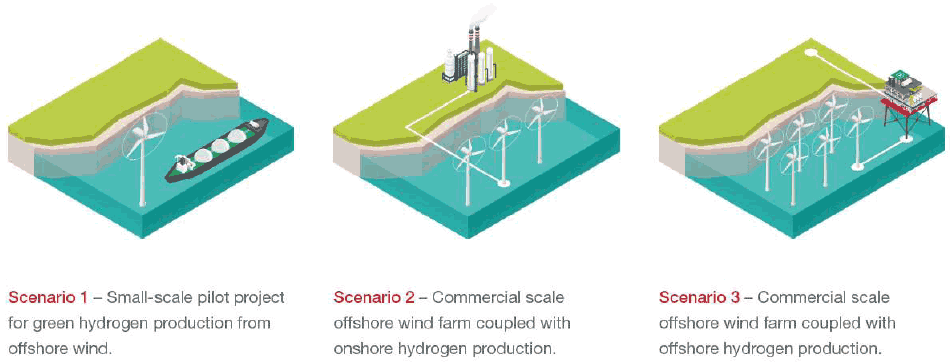
The cost model allows most of the inputs to these three base scenarios to be modified, enabling inspection of a wide range of possible configurations of wind farm technology (fixed or floating), hydrogen generation and transport. The model will be handed over to the project consortium as a project deliverable. However, this section of the report only presents and discusses the results for the three agreed baseline scenarios. The full characteristics of these are identified below, after a description of the cost modelling methodology.
4.2.1 Methodology of Cost Model Building
The cost model is a Microsoft Excel spreadsheet, with the calculation broken down into CAPEX, OPEX, hydrogen generation, and transport costs. A high-level view of the hydrogen cost modelling methodology is outlined in the diagram below in Figure 4.2.
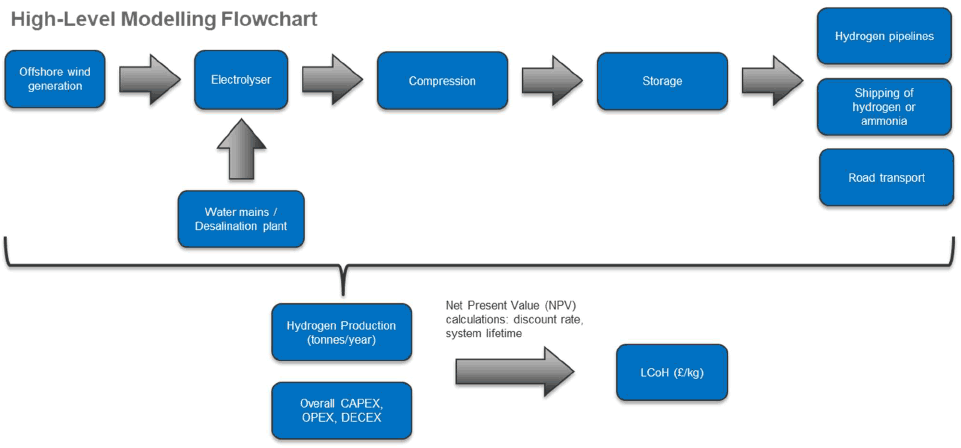
As the primary focus of the model is to differentiate between hydrogen generation scenarios, the offshore wind farm interface has been purposefully left simple. CAPEX and OPEX values in £/MWh are assumed for each scenario to compute the total costs of the wind farm. The model offers a choice between floating and fixed offshore wind, reflected in the £/MWh value selected. The annual electricity generation from the wind farm is defined by simply multiplying the total wind farm capacity by an average annual capacity factor. CAPEX and OPEX values were taken from Xodus’ internal offshore wind LCOE modelling tool.
For the purposes of this cost model and as agreed with study partners during the framing of model scenarios, PEM electrolysers are assumed for hydrogen production. It is recognised that there are several competing electrolyser technologies, and likely to be further emerging new technologies during the period of energy transition considered in this report. The model allows the user to select whether the electrolyser location is offshore or onshore. Hydrogen production in tonnes/year is computed from the electrolyser capacity and utilisation rate. Power for the balance of plant is assumed to come from the offshore wind farm, and this is taken into count when computing the amount of hydrogen produced. Balance of plant includes compression for all scenarios, and desalination for scenarios where the electrolyser is placed offshore. If the electrolyser is placed onshore, Scottish water mains is used as a default for the electrolyser feedwater.
OPEX costs for balance of plant are taken as a percentage of the equipment CAPEX. For the electrolyser, stack replacement after a set number of operating hours is built into the OPEX costs. If balance of plant equipment design life is set as shorter than the project duration, then equipment replacement costs are also taken into account. Decommissioning costs are added for the last year of operation.
Hydrogen transport costs are divided between offshore and onshore delivery costs. In cases where the electrolyser is located offshore, hydrogen offtake can be selected to occur via a subsea hydrogen pipeline or vessels to an onshore location, from where further delivery via gaseous trucking or direct use can be selected. For the largest commercial scale scenario, export over long distances as ammonia or in an additional export pipeline is also included as an option in the delivery costs. An option is also included for onshore buffer storage. If ‘no storage’ is selected, it is assumed that the product hydrogen is fed directly into the gas grid or used onsite.
Predicted technological learning curves were derived from data taken from research publications to account for increased stack lifetime, reduction in electrolyser CAPEX and reduction in stack replacement cost with time. The model also includes an economies of scale factor accounting for the reduction in unit cost with each additional unit. This factor is applied to electrolyser procurement costs.
The scenarios have not been designed for specific locations, and the distance to shore is theoretical, defined based on the type of project in question. For example, the pilot project is likely to be close to shore, whereas a large commercial scale wind farm generating hydrogen offshore will be situated much further from the coast.
In the final step of the calculation, the NPV of the CAPEX, OPEX, transport costs and hydrogen produced are computed over the lifetime of the wind farm, using a 5% discount rate, to define the LCoH. It is important to note that the model was not intended as a full financial model, but as a comparison between three generation scenarios and for understanding the key cost drivers of green hydrogen.
4.2.2 Cost Model Scenarios and Assumptions
The three model scenarios and relevant assumptions are detailed below.
4.2.2.1 Scenario 1: Pilot Project
Scenario 1 assumes a single turbine, with an electrolyser and desalination unit built onto the same turbine foundation. The hydrogen produced offshore is stored until it is offloaded onto a transport vessel in gaseous form. No onshore storage or further delivery is included, with the assumption that the product hydrogen will be used at the vessel arrival port. Because hydrogen is produced offshore, no export cable is included. The full inputs for scenario 1 are listed below in Table 4.1 The high-level flow chart for Scenario 1 is also shown below.
| Variable | Value | Unit |
|---|---|---|
| Turbine capacity | 14 | MW |
| Wind farm capacity | 14 | MW |
| Number of turbines | 1 | |
| Actual project capacity | 14 | MW |
| Distance from the shore | 25 | km |
| Wind farm technology | Fixed | |
| Electrolyser location | Offshore | |
| End of construction year | 2025 | |
| Project design life | 30 | years |
| Fresh water supply | Desalination | |
| Transport type | Vessel | |
| Onshore hydrogen storage | No storage | |
| Onshore hydrogen delivery | No delivery | |
| Discount rate | 5% | |
| Electrolyser size | 494 | MW |
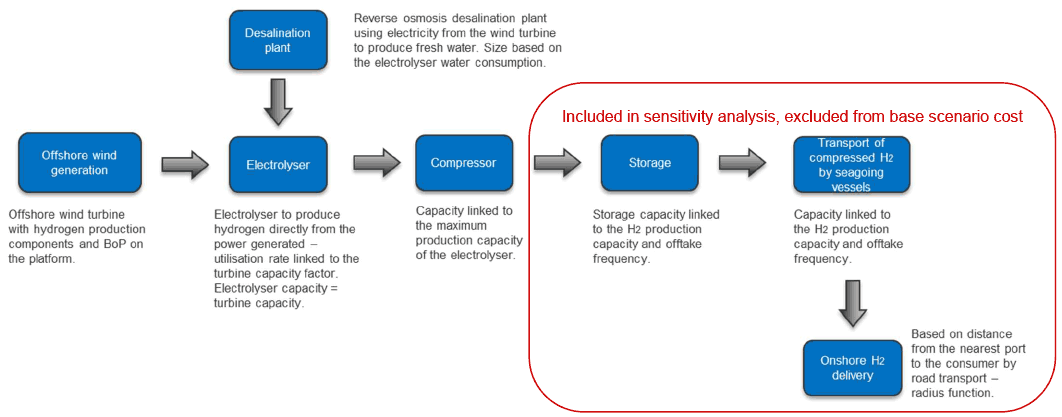
4.2.2.2 Scenario 2: Grid connected wind farm with partial hydrogen generation onshore
Scenario 2 is hydrogen generation onshore from a commercial scale (500MW) fixed offshore wind farm. An export cable runs from site to an onshore electrolyser, sized to match the capacity of the wind farm. For the baseline model results presented here, the wind farm is not grid connected and no network charges are included. However the model enables the user to inspect grid connected scenarios where network charges are taken into account. In such a scenario, the export cable and other transmission infrastructure are sold to the offshore transmission owner (OFTO) at the end of construction. As the model is not location dependent, TNUoS and BSUoS charges have been averaged across the Scottish regions. A 3% economies of scale rate per unit has been applied to the electrolyser procurement costs. Table 4.2 and Figure 4.4 below outline the assumptions for Scenario 2.
| Variable | Value | Unit |
|---|---|---|
| Turbine capacity | 14 | MW |
| Wind farm capacity | 500 | MW |
| Number of turbines | 36 | |
| Actual project capacity | 504 | MW |
| Distance from the shore | 50 | km |
| Wind farm technology | Fixed | |
| Electrolyser capacity | 494 | MW |
| End of construction year | 2028 | |
| Project design life | 30 | years |
| Fresh water supply | Water mains | |
| Transport type | Export cable | |
| Onshore hydrogen storage | No storage | |
| Onshore hydrogen delivery | No delivery | |
| Learning rate | 10% | |
| Economies of scale | 3% | |
| Discount rate | 5% |
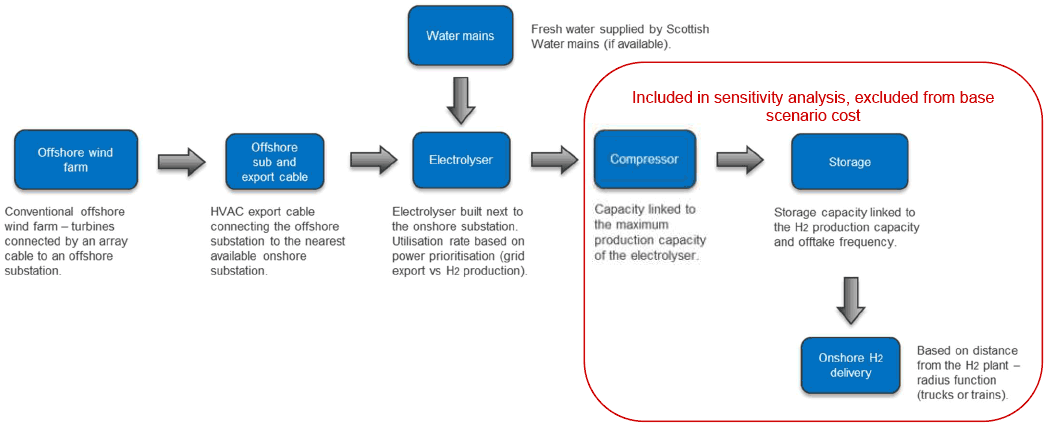
4.2.2.3 Scenario 3: Hydrogen generation offshore from a commercial scale wind farm
Scenario 3 is a large commercial scale offshore wind farm, purpose built for hydrogen generation. The wind farm is not grid connected, and all the energy generated is used for hydrogen production. The electrolysers are located offshore, and the hydrogen is transported to an onshore facility using a subsea pipeline. No further storage or export is included in the baseline scenario.
A 10% learning rate has been applied to stack degradation, and a 3% economies of scale rate per unit has been applied to the electrolyser procurement costs. Table 4.3 and Figure 4.5 outline the assumptions for scenario 3.
| Variable | Value | Unit |
|---|---|---|
| Turbine capacity | 14 | MW |
| Wind farm capacity | 1000 | MW |
| Number of turbines | 72 | |
| Actual project capacity | 1008 | MW |
| Distance from the shore | 100 | km |
| Wind farm technology | Fixed | |
| End of construction year | 2032 | |
| Project design life | 30 | years |
| Fresh water supply | Desalination | |
| Transport type | Pipeline | |
| Onshore hydrogen delivery | No delivery | |
| Export delivery distance (Scotland to Europe) | No export in baseline scenario | km |
| Export delivery type | No export in baseline scenario | |
| Onshore hydrogen storage | No storage | |
| Learning rate | 10% | |
| Economies of scale | 3% | |
| Discount rate | 5% | |
| Electrolyser size | 1008 | MW |
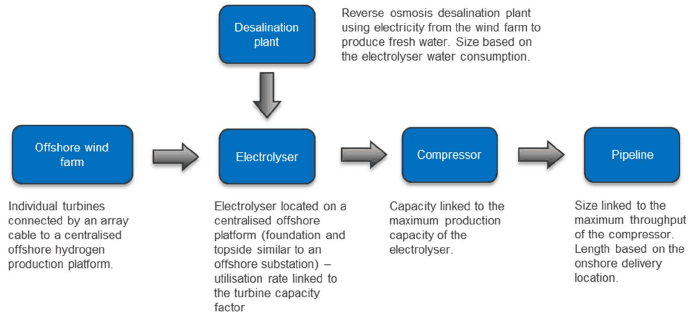
4.2.2.4 Model assumptions
The values for the key input parameters for all three scenarios are listed in Table 4.4 and Table 4.5
The full list of references for each of the values used is available as part of the Excel model.
| Variable | Unit | Scenario 1 | Scenario 2 | Scenario 3 |
|---|---|---|---|---|
| Offshore wind CAPEX (excl. export and array cables) - Fixed | £/MW | 2,726,300 | 2,528,600 | 2,190,000 |
| Export cable CAPEX | £/m | - | 1,000 | - |
| Pipeline to Shore CAPEX | £/m | - | - | 650 |
| Project DEVEX | % CAPEX | 5 | 5 | 5 |
| Array cable CAPEX | £/m | Not included | 580 | 580 |
| Electrolyser CAPEX | £/MW | 568,749 | 484,704 | 391,638 |
| Compressor CAPEX | £/(tonne/day) | 240,000 | 240,000 | 240,000 |
| Variable | Unit | Scenario 1 | Scenario 2 | Scenario 3 |
|---|---|---|---|---|
| Offshore wind OPEX/year - Fixed | £/MW/year | 69984 | 69984 | 69984 |
| Offshore wind DECEX | £/MW | 330,000 | 330,000 | 330,000 |
| Hydrogen DECEX | % CAPEX | 2% | 2% | 2% |
| Electrolyser OPEX | % CAPEX/year | 2% | 2% | 2% |
| Lifetime of stack | Hours of operation | 50,238 | 60,667 | 80,238 |
| Cost of stack replacement | £/MW | 175,647 | 141,758 | 106,518 |
| Desalination OPEX | £/m3 | 1.6 | - | 1.6 |
| Desalination lifetime | years | 30 | - | 30 |
| Scottish Water charge | £/m3 | - | 0.89 | - |
| Compressor OPEX | % CAPEX | 6% | 6% | 6% |
| Compressor lifetime | years | 30 | 30 | 30 |
| Pipeline OPEX | £/year | - | - | 140,000 |
4.2.3 Scenario Results
The results for the three base scenarios are presented below in Table 4.6. The breakdown of the lifetime costs for each of the scenarios is also shown graphically in Figures 4.6 to 4.8.
| Result | Unit | Scenario 1 | Scenario 2 | Scenario 3 |
|---|---|---|---|---|
| LCOH | £/kg | 6.24 | 2.91 | 2.26 |
| Total CAPEX (NPV) | £m | 46 | 1,168 | 1,699 |
| Total lifetime OPEX (NPV) | £m | 19 | 144 | 248 |
| Average hydrogen production | tonnes/day | 3 | 119 | 276 |
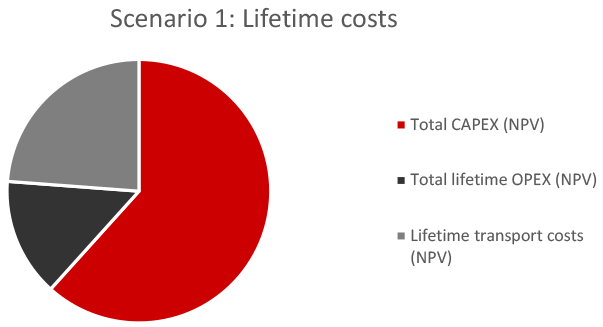
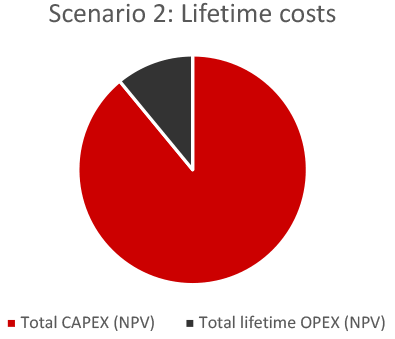
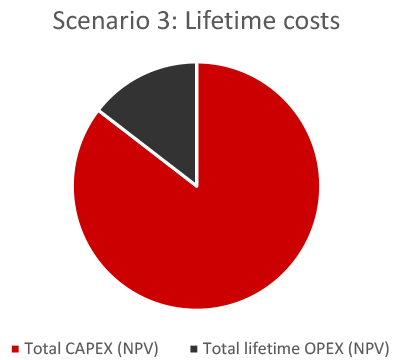
Scenario 1 LCoH is the highest of the three scenarios at £6.24/kg. This is due to the small capacity of the project. Since the electrolyser is located offshore, vessel transport of produced hydrogen also increases the LCoH. Since the construction of the project occurs in 2025, the electrolyser CAPEX costs are also expected to be significantly higher per MW than for Scenarios 2 and 3. Similarly, the stack lifetime and replacement costs are higher for scenario 1 due to the early timeline. Due to the single unit, no economies of scale or technological learning was applied to Scenario 1, further increasing the LCoH.
The LCoH is for Scenario 3 is the lowest of the three at £2.26/kg. Scenario 2 has an LCoH similar to scenario 2, at £2.91/kg. Scenario 3 LCoH is lower due to the following reasons:
- Offshore electrolyser: Pipeline CAPEX is lower than export cable CAPEX;
- Later delivery year: 2032 compared to 2028; and
- Export cable losses: greater hydrogen production due to no export cable losses;
4.2.4 Sensitivity Analysis
A sensitivity analysis was completed on the LCoH model to identify the key cost drivers for each of the scenarios. The three scenarios presented above are only examples of how the model can be used. In the sensitivity analysis, the model input parameters were modified to their limits for each of the scenarios. Only a single parameter was modified from the original base scenario and the effect on the LCoH recorded. The results of the sensitivity analysis are detailed in Table 4.7 to 4.9.
| Input variable | Base scenario | Sensitivity analysis | Effect of LCoH | New LCoH (£/kg) |
|---|---|---|---|---|
| Baseline LCoH | 6.24 | |||
| Turbine foundation | Fixed | Floating | +29% | 8.07 |
| Windfarm CAPEX estimate (fixed) | Conservative | Ambitious | -12% |
5.51 |
| Electrolyser location | Offshore | Onshore | -13% |
5.43 |
| Project design life | 30 years | 15 years | +24% | 7.74 |
| Onshore storage & delivery (gaseous trucking) | No | Yes | +21% | 7.56 |
| Discount rate | 5% | 10% | +33% | 8.27 |
| Discount rate | 5% | 2.5% | -13% |
5.43 |
| Input variable | Base scenario | Sensitivity analysis | Effect of LCoH | New LCoH (£/kg) |
|---|---|---|---|---|
| Baseline LCoH | 2.91 | |||
| Distance from shore | 50km | 100km | +3% | 3.00 |
| Distance from shore | 50km | 25km | -1% |
2.87 |
| Windfarm CAPEX estimate (fixed) | Conservative | Ambitious | -26% |
2.14 |
| End year of construction | 2028 | 2032 | -22% |
2.26 |
| Water supply | Mains | Desalination | +1% | 2.93 |
| Onshore storage & delivery (gaseous trucking) | No | Yes | +58% | 4.60 |
| Discount rate | 5% | 10% | +63% | 4.76 |
| Discount rate | 5% | 2.5% | -24% |
2.20 |
| Turbine foundation | Fixed | Floating | +70% | 4.94 |
| Electrolyser CAPEX | 485,000 | +25% | +4% | 3.02 |
| Electrolyser CAPEX | 485,000 | -25% |
-4% |
2.80 |
| Electrolyser size | 494MW | 400MW | +19% | 3.47 |
| Input variable | Base scenario | Sensitivity analysis | Effect of LCoH | New LCoH (£/kg) |
|---|---|---|---|---|
| Baseline LCoH | 2.26 | |||
| Turbine foundation | Fixed | Floating | +67% | 3.77 |
| Windfarm CAPEX estimate (fixed) | Conservative | Ambitious | -23% |
1.74 |
| Distance to shore | 100km | 200km | +2% | 2.31 |
| Distance to shore | 100km | 50km | -1% |
2.24 |
| Export to Europe | None | Pipeline | +10% | 2.49 |
| Export to Europe | None | Ammonia | +45% | 3.27 |
| Onshore storage & delivery (gaseous trucking) | No | Yes | +65% | 3.72 |
| Discount rate | 5% | 10% | +62% | 3.66 |
| Discount rate | 5% | 2.5% | -24% |
1.72 |
The sensitivity analysis shows that the LCoH is highly dependent on the following:
- Foundation type (floating vs fixed);
- Wind farm CAPEX estimate (conservative vs ambitious);
- Inclusion of transport and storage costs; and
- Discount rate.
The following factors have relatively little effect of LCoH:
- Fresh water supply (Scottish water mains vs. desalination); and
- Distance to shore.
The LCoH is significantly affected by the transport and export costs included. Table 4.10 below shows the assumptions used in defining the transport costs in the model. To provide a fair comparison, none of the baseline scenarios include any transport costs. However, when examining the financial feasibility of the scenarios, it is important to consider the cost implications related to storage and delivery. The sensitivity analysis for Scenarios 2 and 3 shows that the inclusion of storage and delivery as gaseous trucking increases the LCoH significantly, by more than 60%. For Scenario 3, export to Europe as Ammonia increases the LCoH by 45%, whereas export via a pipeline is significantly more cost effective, at only a 10% increase to the baseline cost.
| Variable | Unit | |
|---|---|---|
| Vessels | £/day | 48,000 |
| Gaseous trucking | £/kg | 0.8 |
| Export Pipeline CAPEX | £/m | 650 |
| Transformation from H2 to NH3 | £/kg | 0.75 |
| Reconversion from NH3 to H2 | £/kg | 0.09 |
| Ammonia export | £/kg | 0.17 |
The model includes two input values for fixed and floating offshore wind CAPEX costs; a conservative estimate and an ambitious estimate. The conservative estimate is based on the Xodus internal CAPEX tool and is considered relevant for 2025-2032 (cost reduction curve of 15% between 2028 and 2032). The ambitious estimate aligns with the inputs of the ORE Catapult in their OSW-H2: Solving the integration challenge report and can be used to model LCoH for scenarios where significant cost reductions in offshore wind costs are anticipated, such as long-term ambitions. The sensitivity analysis shows that ambitious wind farm CAPEX figure lowers the LCoH by approximately 25%.
The key output of the sensitivity analysis is that the LCoH is highly dependent on how the baseline scenarios are defined and how much of the post-processing and delivery are included. Overall, the results of the three baseline scenarios were as anticipated and align with other cost-models in the public domain. For example. Scenario 3 is similar to the scenarios explored by ORE Catapult in their OSW-H2: Solving the integration challenge report. For 2030, OREC predict a £2.2/kg LCoH for a fixed 1.2GW offshore wind farm with offshore generation. This is very close to the Scenario 3 baseline LCoH of £2.26/kg.
4.2.5 Summary
Levelised cost of hydrogen (LCoH) has been estimated for three base case production scenarios:
- Scenario 1: Small-scale pilot project for green hydrogen production from offshore wind;
- Scenario 2: Commercial scale offshore wind farm coupled with onshore hydrogen production;
- Scenario 3: Commercial scale offshore wind farm coupled with offshore hydrogen production.
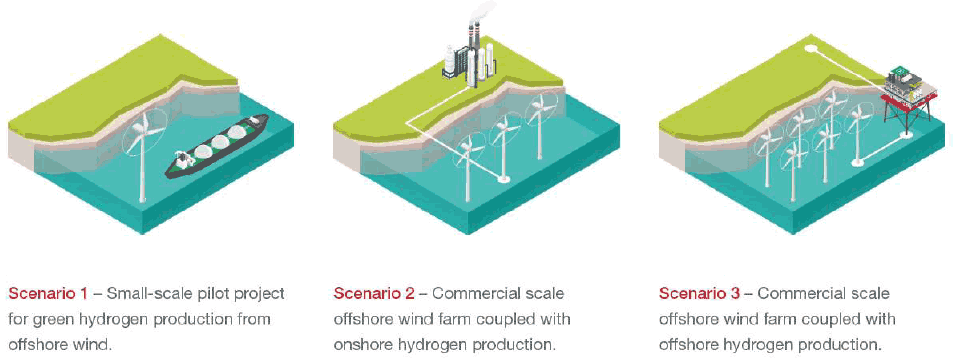
| Result | Unit | Scenario 1 | Scenario 2 | Scenario 3 |
|---|---|---|---|---|
| Year | 2025 | 2028 | 2032 | |
| Wind Farm Capacity | MW | 14 | 500 | 1000 |
| Hydrogen Production | Te/day | 3 | 119 | 276 |
| LCoH | £/kg | 6.2 | 2.9 | 2.3 |
- As expected, the results of the modelling show the cost of hydrogen production decreasing with reducing technology cost and increased scale. Xodus’ analysis supports a long term outlook of LCoH falling towards £2/kg for fixed bottom offshore wind turbines.
- Floating wind and any additional costs for transportation significantly increase the LCoH. The cost of hydrogen at the point of use must therefore take these logistics components into account on a case by case basis.
- Desalination cost and distance to shore do not significantly influence LCoH.
4.3 Hydrogen Policy Analysis
The possibility of using hydrogen to decarbonise various energy-intensive sectors has been considered within wider energy policies in many countries to date. However, dedicated national hydrogen strategies are starting to emerge only in the past two years, with one exception, Japan, which has been a hydrogen leading nation for decades. Other countries, including the UK, Germany or Australia, are now following the suit and recognising hydrogen as a viable option to meet their net-zero targets. Australia and Germany have now published their national hydrogen strategies, EU Green Deal recognises hydrogen sector as a key player, and the Scottish and the UK Governments are also increasingly considering the next steps to support hydrogen supply and use from the late 2020s onwards. This section summarises the most recent developments in the hydrogen policy arena to support Scotland’s 2045 net-zero target and what may be required to replace fossil fuels with green hydrogen instead.
4.3.1 EU Hydrogen Policy Landscape
The EU has pursued its long-term decarbonisation strategy which includes a hydrogen pathway to achieve the net-zero target. The EU has committed to support hydrogen production from renewable sources, and to set up the Hydrogen Energy Network as a platform to connect EU member states and encourage further discussion about the benefits and barriers associated with hydrogen economy. This has emerged from the Linz Declaration Hydrogen Initiative, which has been signed by 28 European countries, and 100 businesses, organisations and institutions to accelerate the uptake of hydrogen technology in the EU (IEA, 2019).
The European Commission has been continuously supporting innovative hydrogen projects through various initiatives, the largest being the Fuel Cell and Hydrogen Join Undertaking (FCH JU) under the Horizon 2020 framework (FCH JU, 2020). FCH JU is an EU-led initiative that supports research, technological development and demonstration activities within the hydrogen sector. FCH JU facilitates a total funding budget of £1.2 billion between 2014 and 2020 (FCH JU, 2020). The FCH JU has already funded 246 hydrogen demonstration projects in Europe, with electrolysers receiving around 80% of the funding (EURACTIV, 2019). The last Call for Proposals included 24 topics and has a budget of £83 million. The FCH JU led to the creation of the Mission Innovation, Renewable and Clean Hydrogen Innovation Challenge, which aims to accelerate the development of a global hydrogen market by identifying and overcoming key technology barriers. The group includes 15 countries that are the most active in hydrogen economy – including the UK and other non-EU members such as Japan or Australia.
4.3.1.1 EU Hydrogen Strategy
A hydrogen strategy for a climate neutral Europe (European Commission, 2020) is a clear example of EU’s dedication to support a wide deployment of hydrogen technologies across Europe and beyond. The strategy is primarily focused on three milestones between 2020 and 2045. From 2020-2024, the goal is to deploy at least 6GW of green hydrogen production facilities, with the capacity of producing 1 million tonnes of green hydrogen per year. In a period of 2025-2030 the Commission expects to see a significant increase of green hydrogen production from 6GW to 40GW to produce 10 million tonnes of hydrogen annually. In 2045, the green hydrogen technology is expected to be deployed at a large scale to decarbonise all hard-to-abate sectors in the EU.
The Commission is convinced that the long-term green hydrogen production will be underpinned by wind and solar generation, which are already the cheapest sources required for electrolysis, and these costs are likely to fall even further. In the in the short and medium terms, the Commission acknowledges that other forms of low-carbon hydrogen will also be required to create a viable, large-scale market.
The development of appropriate certification and lifecycle assessment will be critical to ensure that supplied hydrogen comes from low-carbon sources. The Commission has committed to introduce a comprehensive terminology and certification, to deliver this commitment. The scheme will be focused on life-cycle carbon emissions, including all components and processes required to produce and deliver green hydrogen to the end-user. This will be underpinned by existing EU legislation and correspond with the EU taxonomy for sustainable investments. Complying with this certification scheme will be critical for Scotland’s potential green hydrogen export to the EU.
The EU hydrogen strategy highlights that the rapid increase of green hydrogen production will be crucial to recover from the COVID-19 crisis. The European Commission recover plan ‘Next Generation EU’ states that investing into hydrogen technologies is a priority to ensure that EU adapts to sustainable economic growth and becomes the leading region of hydrogen development by creating long-term, resilient jobs. The EU Green Deal also considers hydrogen to be an important part of Europe’s energy future, including innovative projects such as zero-carbon steel making.
4.3.1.2 Europe’s Hydrogen Leading Countries
Two of the most active European countries that drive hydrogen technology innovation and pilot project deployment are the Netherlands and Germany. Both countries agreed on an official hydrogen cooperation in October 2019, following the Eur 20 million EU funding from FCH JU for the Hydrogen Valley project for Northern Netherlands (Hyer, 2019). The aim of this mutual collaboration is to develop a dedicated European hydrogen directive, initially led by the Netherlands and Germany together with their northwest Europe partners (Austria, Belgium, France, Luxemburg and Switzerland) (Fuel Cell Works, 2019).
The German Government has already been supporting hydrogen-related projects through their National Innovation Programme for Hydrogen and Fuel Cell Technologies. The current 10-year programme (2016-2026) includes £1.25 billion funding from the German Government and additional a £1.8 billion funding from private investors. The programme is primarily focused on publicly accessible hydrogen refuelling stations and hydrogen fuel cell modes of transport (IEA, 2019). The German Government also funded the world’s first hydrogen-powered train.
In June 2020, Germany published its first dedicated hydrogen strategy: The National Hydrogen Strategy (German Federal Government, 2020). The strategy aims to develop German’s hydrogen sector, whilst highlighting the key opportunities and barriers related to hydrogen supply and end-use. Considering the population density and economy based on industrial processes, it is likely that Germany will require hydrogen import from other European countries to decarbonise its energy-intensive sectors. This is where Scotland-Germany partnership could become a viable solution.
The Strategy highlights that strong international partnerships will be critical to deliver the hydrogen market scale required. Germany is particularly interested in creating new energy partnerships with countries that already have active development cooperation with and potential energy exporters with significant renewable energy resources to produce green hydrogen. Scotland is therefore an ideal candidate to meet both of these requirements. Producing green hydrogen from wind energy and exporting it to Germany by subsea pipelines or ships could become an important trade relationship between the two countries. The list of selected countries for potential cooperation will be produced during the German EU Council Presidency (German Federal Government, 2020).
Pipelines and ammonia are mentioned in the Strategy as the key options for long-distance hydrogen transport based on the existing infrastructure and capabilities. Liquid hydrogen or LOHCs could also become increasingly important. However, these technologies are less mature compared to the former.
The Strategy also calls for appropriate standardisations and certification, similarly to the EU Hydrogen Strategy. Successful establishment of the international hydrogen market will be reliable upon proof of origin for power used for electrolysis, as well as sophisticated standards for high-quality hydrogen infrastructure. Therefore, the German Federal Government has committed to join up with other countries to create universal standards and codes within the international hydrogen market.
4.3.2 Other Hydrogen Leading Regions
Hydrogen technology innovation in the Asia-Pacific (APAC) region is currently driven predominantly by Japan, Australia, China and South Korea. Some countries have published dedicated national hydrogen strategies (Australia in November 2019 (COAG, 2019) and Japan in December 2017 (Japanese Government, 2017)), which include estimations of their future hydrogen demand and supply and outline potential paths how to get there. While Japan is already a global leader in hydrogen technology with operational strategy to import hydrogen to meet their growing demand, the Government of Australia has officially committed to hydrogen technology in 2019 through its dedicated national strategy, mainly focused on the production side.
Japan is planning to import around 12 TWh by 2030, as well as investing heavily in research and investments into international hydrogen supply chains and end-use technology (Committee on Climate Change, 2018). Australia has several projects in the pipeline to export hydrogen to Japan. This cooperation is a similar relationship to Scotland and continental Europe, where Scotland could export green hydrogen from its abundant renewable energy resources to support decarbonisation efforts in densely populated countries with less abundant renewable energy resources.
The idea of exporting energy from regions with abundant, low-cost resources to locations with higher demand is not new. Importing renewable electricity from northern Africa to Europe has been considered in the past. Although there are several complex non-technical issues that are not in a favour of this development, there are also some technical obstacles to overcome, such as the prohibitive cost of power transmission lines from Africa to Europe. Hydrogen, on the other hand, can be used as an energy vector to overcome long-distances in pipelines, ships, or trucks, whether gaseous, liquified, or stored in other forms, which costs much less than power transmission cables (FCH JU, 2019). This is the main reason why sparsely populated Australia with abundant solar, wind and coal resources is interested in supplying Japan with hydrogen carried on board of ships.
4.3.3 Scotland’s Hydrogen Policy Landscape
Opportunities associated with a wide deployment of hydrogen technology in Scotland are thoroughly explored in the Scottish Government’s most recent energy-related policy papers. Both the Scottish Energy Strategy published in 2017 and the Electricity and Gas Network Vision for 2030 published in 2019 focus on the whole-systems approach, which aligns well with hydrogen production and use. The Scottish Government’s commitment to become a leading hydrogen nation has already paid off with Scotland being the world’s first to produce hydrogen from tidal energy (Surf’n’Turf), and combining anaerobic digestion, combined heat and power and electrolysis to produce and utilise hydrogen and oxygen as part of the OHLEH project. Furthermore, Scotland is now planning to deploy the first seagoing renewable-powered hydrogen ferry (HySeas III), develop the first offshore hydrogen production from floating wind (Dolphyn) and build the first large-scale offshore CCS plant to produce hydrogen (Acorn Hydrogen). All these projects were financially supported by the Scottish Government, UK Government, or the EU.
The Vision for 2030 paper states that Scotland’s gas network will remain a crucial component of the national infrastructure which will keep delivering affordable energy to heat homes and businesses. The policy, regulatory and technical developments will have to be designed in a way that will allow natural and low carbon gas to be blended in the networks, including a contribution from hydrogen. The Scottish Government has committed to understand the feasibility and associated costs of repurposing the gas networks to accommodate 100% hydrogen supply (Scottish Government, 2019). By 2030, the Scottish Government has committed to implement strategic decisions about the long-term role of the gas networks which is likely to deliver desired certainty around the deployment of hydrogen systems in Scotland.
The Scottish Government is planning to build upon their previous support for hydrogen projects. They are currently preparing an interactive mapping tool which will display current hydrogen activity in Scotland and showcase specific hydrogen production and use opportunities on a region by region basis (Scottish Government, 2019). The Scottish Government has also committed to continue working with external stakeholders to advance hydrogen energy and transport initiatives, accompanied by clear analysis and policy statements associated with the role of hydrogen in Scotland’s future energy system. The most important developments in Scotland that are on the horizon are as follows (CMS, 2020);
- Hydrogen Accelerator Programme
- Hydrogen Assessment Project
- Action Plan for Development of Hydrogen Economy
- Hydrogen Fuel Cell Train Pilot Projects
4.3.4 Potential Hydrogen Policy and Market-Driven Incentives
Green hydrogen projects in Scotland, as well as worldwide, have been funded predominantly on a project-by-project basis to climb the Technology Readiness Level (TRL) ladder. However, consistent and long-term support schemes will be required for the green hydrogen technology to enter the large-scale deployment stage. These schemes could use lessons learned from the renewable power generation sector, either policy-led (such as Renewable Obligation or Contracts for Difference), or market-based (such as Power Purchase Agreements). These schemes will be critical for Scotland to meet its net-zero target by 2045 if hydrogen is to play an important role in the future energy mix. This section discusses what schemes could be adopted to support green hydrogen development in Scotland.
4.3.4.1 Renewable Transport Fuel Obligation
Renewable Transport Fuel Obligation (RFTO) is the UK Government incentive scheme to decrease the carbon footprint within the transport sector by supporting the use of biofuels (UK Gov, 2019). RFTO is a requirement for transport fuel suppliers to ensure that a certain proportion of their fuel sold comes from biofuels. This obligation-based scheme is a similar one to the electricity generation sector, which boosted the renewable power generation capacity through Renewable Obligation Certificates (ROCs).
Using green hydrogen within the transport sector is likely to be one of the most cost-competitive sectors, based on the results in Section 3. Hydrogen is already categorised under the RTFO as a development fuel, although it does not apply to grid electricity electrolysis nor states any percentage of transport fuels to come from green hydrogen. Setting a certain percentage to come from electrolysis rather than fossil fuels (with the percentage increasing gradually every year) could significantly increase the use of green hydrogen within the transport sector.
Since electric vehicles will inevitably play an important role in the decarbonisation efforts of the transport sector (particularly light-duty vehicles), the RFTO should ensure that it supports low-carbon technologies to replace petrol and diesel, and not discourage electrification. This scheme could unlock the use of hydrogen in the transport sector in a consistent and predictable way, without requiring funding support based on a project-by-project basis.
4.3.4.2 Low Carbon Obligation
Low Carbon Obligation (LCO) could follow a similar method to RFTO but focusing on the heat sector instead of transport. The heat sector is the most promising sector in terms of hydrogen demand potential but equally the least cost-competitive sector compared to the fossil fuel replaced. Therefore, the LCO scheme would have to be designed in a way to ensure that heating bills do not significantly increase by replacing natural gas with more expensive green hydrogen.
Scotland is ideally located for hydrogen blending, due to the significant offshore wind resources and the presence of St Fergus gas terminal. Therefore, LCOs focused on low-carbon heating could boost the uptake of green hydrogen technologies in Scotland, whilst helping to decarbonise Scotland’s heat sector by 2045.
4.3.4.3 Hydrogen Purchase Agreements
Hydrogen Purchase Agreement (HPA) could become a market-based solution based on the same principle of the conventional Power Purchase Agreement (PPA). HPA would be created between a green hydrogen producer and a hydrogen end-user by setting a certain sale price (£/kg) and amount used in a given timeframe (e.g. in kg/day). This market-driven solution could help to solve the ‘chicken and egg’ situation between hydrogen supply and demand.
Although HPAs would be market-driven, certain standardisation and rule compliance will be required from the policymakers and regulators, to protect both sides. Purchase Agreements are already common in the renewable power sector, and they can also create a level-playing field in the hydrogen sector, especially if combined with other policy-led mechanisms such as the combination of CfD and PPA in the renewable electricity sector (OFGEM, 2020).
4.3.4.4 Green Electricity CfD Auctions with Electrolysis Option
It might be possible to incentivise increased use of hydrogen and electrolysis through modifications to the existing CfD auction infrastructure currently in place to support low-carbon electricity technologies. Rather than offering a CfD for hydrogen technologies directly, a stipulation could be introduced that zero-carbon asset operators would only receive payment for electricity delivered either directly to the grid or into an electrolyser (with electrolysis only being an option when the grid is saturated). This would allow the asset operator to produce hydrogen at a very competitive price should they face curtailment.
Further cost reductions could be encouraged should feed-in priorities be made tradeable. Investment in electrolysers would only be attractive to asset-owners who are likely to face curtailment. Should one developer be based in a location with strong grid connection but poor hydrogen delivery options, and another in a location with strong hydrogen delivery options but a poor grid connection, they could trade feed-in priorities such that the former is able to maximise production to the grid, where the latter produces hydrogen. This would encourage market efficiency.
4.3.4.5 Emission Abatement Potential and Subsidies
To close the gap between hydrogen supply cost and the end-user price in sectors that are unlikely to compete with fossil fuels under current tax regimes, there are two ways to be introduced. The first option is to provide direct subsidy to lower the costs associated with green hydrogen production, storage and delivery to the end user. This would enable the final price of green hydrogen to be equal to the cost of fossil fuels used in the given sector. This could be referred to as positive subsidy.
The second option is to penalise carbon emitting sectors by introducing carbon price based on the carbon intensity of each fuel based on the emission abatement potential within each sector.
This section discusses how much hydrogen could be taxed or how much subsidy will be required to replace existing fossil fuels either by positive subsidy or emission penalty.
Hydrogen could replace different types of fossil fuels across various energy sectors, such as road transport, low-grade and industrial heat, chemical feedstock, electricity, ferries or aviation. Each of the sectors use different fuels and technologies with different efficiencies. The carbon intensity of each sector shown in Figure 4.9 identifies sectors that are the most promising to become decarbonised by replacing traditional technologies that use fossil fuels with green hydrogen. These carbon intensity results (also referred to as emission abatement potential) were based on technologies assessed in Section 2.4.
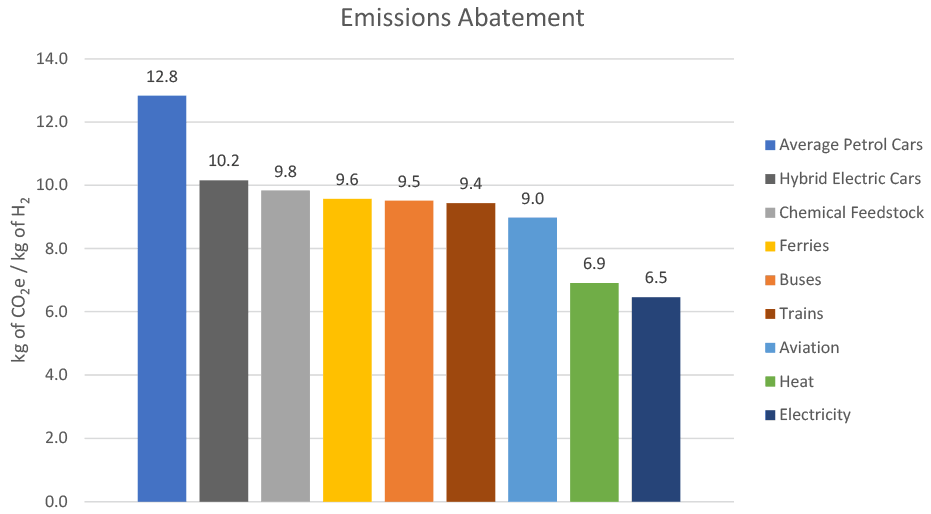
Similarly to Section 2.4, each sector comparison shown in Figure 4.8 is based on delivering the equivalent service. This can be demonstrated on a road transport example: 0.94 kg of green hydrogen will allow an FCEV to travel 100 km. The same distance will require 5.5 litres of petrol when using an average petrol car. Travelling 100 km in a petrol car would emit 12.8 kg of carbon dioxide equivalent according to the UK Government’s Conversion Factors document, which states a figure of 2.2 kg of carbon dioxide equivalent per litre of petrol used (UK Gov, 2019). It should be noted that the emission abatement potential is linked not only to the fuel used (UK Government’s Conversion Factors) but also to the efficiency of each technology used across various sectors.
With regards to Conversion Factors, kerosene for aviation and MGO have the highest carbon dioxide equivalent factor per kg of fuel used, followed by petrol and diesel. Natural gas has the lowest emission factor. Conversion factors that were used for the emissions abatement potential calculations are shown in Table 4.11
| Fuel | Unit | kg CO2e |
|---|---|---|
| Natural gas | tonnes | 2542.04 |
| cubic metres | 2.03053 | |
| kWh | 0.18385 | |
| Aviation turbine fuel | tonnes | 3218.92 |
| litres | 2.29105 | |
| kWh | 0.24455 | |
| Diesel | tonnes | 3088.23 |
| litres | 2.59411 | |
| kWh | 0.24462 | |
| Petrol | tonnes | 2997.5 |
| litres | 2.20904 | |
| kWh | 0.23373 | |
| Marine fuel oil | tonnes | 3159.55 |
| litres | 3.12209 | |
| kWh | 0.26298 |
Regarding efficiency improvements when replacing fossil fuel technology with hydrogen, transport modes running for long durations without frequent start-stop situations run at the optimum regime of the engine, and therefore the engine performance is the closest to the nameplate efficiency. This applies to sectors such as ferries. On the other hand, buses and particularly cars are the most penalized by the start-stop nature of urban traffic, as they waste energy on idling or part load. Therefore, replacing fossil fuel technologies with hydrogen are anticipated to improve the least for ferries, whereas buses and cars are anticipated to improve the most. This is the reason why emission abatement potential per 1 kg of hydrogen used is the highest in cars, even though 1 kg of petrol has lower Conversion Factor compared to other liquid hydrocarbons.
In this analysis, aviation has the lowest emissions abatement potential since the future technology is still unknown, so only LHV of each fuel were compared in Section 2.4 without any efficiency improvements assumed. Therefore, emission abatement potential of aviation shown in Figure 4.8 is only indicative and further analysis will be required to obtain more accurate results
1 kg of green hydrogen can be seen to avoid significantly more emissions when it is used to replace liquified fossil fuels (such as marine gas oil, kerosene, petrol or diesel) compared to natural gas used for heating or back-up electricity generation.
The lower the emissions abatement potential, the more difficult it would be for green hydrogen to compete with fossil fuels if carbon price was introduced. Put another way, the lower the emissions abatement potential, the higher carbon price would be required to level the playing field.
Carbon price required for each sector to level the playing field between fossil fuels and green hydrogen can be calculated as follows;
Carbon Price (£/tonne of CO2e) = Cost of Hydrogen Supply (£/kg) – Cost Parity per Sector (£/kg) / Emissions Abatement Potential (kg of CO2e / kg of H2) * 1,000
There are several uncertainties to be addressed before this approach can be applied, with some of them being out with the scope of this study. Firstly, cost of hydrogen supply needs to include not only cost of green hydrogen production from offshore wind (see Section 4.2) but also all the costs associated with delivering this hydrogen to the end-user. For example, in road transport, hydrogen would need to be transported to refuelling stations that require on-site hydrogen storage and dispensers. Secondly, cost parity per sector varies significantly depending on Fuel Duty and VAT applied, and it was out with the scope of this study to analyse potential changes within the HMRC existing tax regime.
To provide a high-level cost comparison of hydrogen supply and cost parity in 2032, Figure 4.10 shows cost parity results within each sector and the range of hydrogen supply cost based on the LCoH model.
The LCoH bottom line of £2.3/kg was based on the baseline results of Scenario 3, which assumed large-scale hydrogen production offshore and delivery to the shore. The upper line added £1.3/kg of hydrogen to the production cost for hydrogen compression, storage and delivery to the end-user in gaseous trucks (see Sensitivity analysis for Scenario 3 in Section 4.2). It should be noted that hydrogen storage on-site at the point of use location (e.g. at the refuelling station) and dispensers were not included in the LCoH values, since the study focused on upstream and midstream only.
It can be anticipated that hydrogen supply costs per kg would be lower for heat and electricity sectors compared to road transport, since hydrogen blended into the existing natural gas network would not require hydrogen tube trailers to be distributed around Scotland, whereas the additional cost of storage and road delivery would be required to supply hydrogen refuelling stations. Figure 4. is intended to provide only a high-level indication of hydrogen cost-competitiveness across various sectors, rather than detailed assessment that would be required to look at each sector in further detail.
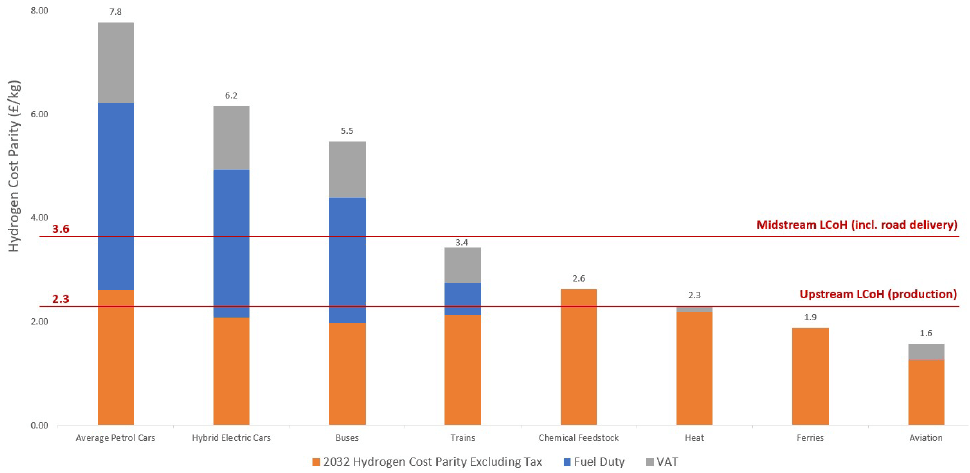
This shows that cars and buses are the only sectors where cost parity exceeds hydrogen supply, which means that hydrogen used in these sectors could be taxed with Fuel Duty and VAT (although at lower rates than current regime) and still compete with existing costs of petrol and diesel. This is predominantly due to the fact that Fuel Duty and VAT currently account for two thirds of petrol and diesel cost.
Green hydrogen used to decarbonise trains and chemical feedstock could be cost-competitive with diesel and Grey hydrogen, respectively, only if the delivery cost is below the upper band of midstream LCoH cost, which is unlikely if gaseous trucking is used for hydrogen delivery. Otherwise these sectors will require subsidy to close the supply-demand cost gap.
The cost parity of remaining sectors is either very similar to the cost of hydrogen production (heat), or well below (ferries, aviation) which suggests that subsidies will be required to level the playing field, especially considering that the overall supply cost will be higher than the bottom band that only shows cost of hydrogen production without storage, or delivery.
Table 4.12 provides a summary of the cost comparison between hydrogen supply and demand, as well as an indication of carbon price that would be required to decarbonise these sectors. It should be highlighted that the calculations were based on cost parity including Fuel Duty and VAT (e.g. hydrogen to power trains would only be cost-competitive with diesel if it was excluded from Fuel Duty and VAT and there was a carbon price of £19/tonne of carbon dioxide equivalent).
Heat sector results were presented as a wide range since the cost of transmission and distribution of hydrogen in the existing gas network was not assessed within the study, but these costs are likely to be lower than transporting hydrogen in gaseous trucks. Electricity was excluded from the summary table due to the uncertainties around cost parity assumptions. Further work will be required to understand the implications and costs associated with replacing natural gas with hydrogen, especially considering that more than half of Scotland’s total energy demand comes from heat (the majority using natural gas).
| Sector | Cost of Hydrogen Production and Delivery (£/kg of H2) | Cost Parity Including Fuel Duty and VAT (£/kg of H2) | Cost Competitive (+) / Subsidy Required (-) (£/kg of H2) |
Difference (%) | Carbon price required (£/tonne of CO2e) |
|---|---|---|---|---|---|
| Average Petrol Cars | 3.6 | 7.8 | +4.2 | +54% | 0 |
| Hybrid Electric Cars | 3.6 | 6.2 | +2.6 | +41% | 0 |
| Buses | 3.6 | 5.5 | +1.9 | +34% | 0 |
| Trains | 3.6 | 3.4 |
|
|
19 |
| Chemical Feedstock | 3.6 | 2.6 |
|
|
99 |
| Heat | 2.3 to 3.6 | 2.3 | 0 to -1.3 | 0% to -57% | 0 to 188 |
| Ferries | 3.6 | 1.9 |
|
|
180 |
| Aviation | 3.6 | 1.6 |
|
|
226 |
It should be reiterated that the cost parity projections and the consequential carbon price estimates only considered the cost of fuel (operating costs) and not the total cost of ownership. Therefore, this analysis should be considered as indicative and could be further improved upon by assessing the total cost of ownership rather than considering operating costs only. Further analysis will be required to obtain more accurate results.
4.3.5 Summary
To enable a wide uptake of hydrogen end-use technologies across Scotland, the capital cost for the initial investment in hydrogen technology is likely to require incentives due to the cost disparity between traditional fossil fuelled technology and newer hydrogen technology. Such example can be seen in the light-duty vehicle sector, where the capital cost required to buy a hydrogen car is significantly higher compared to an equivalent petrol vehicle. However, when considering only operating costs associated with the cost of fuel, the analysis concluded that in 2032 green hydrogen used in cars and buses could be taxed (although at a lower rate than current Fuel Duty and VAT) and still be cost-competitive with current fossil fuel prices.
The rest of the sectors will require subsidies to level the playing field with the existing use of fossil fuels. Although a carbon price of around £200/tonne of carbon dioxide equivalent seems like an ambitious number, it is not unrealistic based on the progressively increasing carbon price in other countries, such as Sweden. Sweden currently has one of the highest carbon prices in the world, which is £100 per tonne of CO2e in 2020 (Swedish Gov, 2020). Sweden’s carbon price is likely to keep increasing as it has been since its introduction in 1991.
If Scotland followed a similar concept, it could enable green hydrogen to become cost competitive with most fossil fuel powered technologies by 2032. Based on the Swedish example, Scotland could follow the suit and introduce an ambitious carbon price to level the playing field and allow low carbon technologies to replace polluting fossil fuels and contribute towards the net-zero target by 2045.
Contact
Email: onshoreoilandgas@gov.scot
There is a problem
Thanks for your feedback